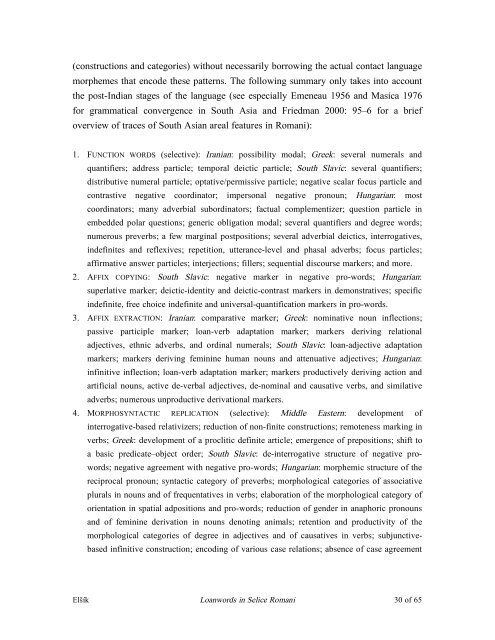Loanwords in Selice Romani, an Indo-Aryan language of Slovakia 1 ...
Loanwords in Selice Romani, an Indo-Aryan language of Slovakia 1 ...
Loanwords in Selice Romani, an Indo-Aryan language of Slovakia 1 ...
You also want an ePaper? Increase the reach of your titles
YUMPU automatically turns print PDFs into web optimized ePapers that Google loves.
(constructions <strong>an</strong>d categories) without necessarily borrow<strong>in</strong>g the actual contact l<strong>an</strong>guage<br />
morphemes that encode these patterns. The follow<strong>in</strong>g summary only takes <strong>in</strong>to account<br />
the post-Indi<strong>an</strong> stages <strong>of</strong> the l<strong>an</strong>guage (see especially Emeneau 1956 <strong>an</strong>d Masica 1976<br />
for grammatical convergence <strong>in</strong> South Asia <strong>an</strong>d Friedm<strong>an</strong> 2000: 95–6 for a brief<br />
overview <strong>of</strong> traces <strong>of</strong> South Asi<strong>an</strong> areal features <strong>in</strong> <strong>Rom<strong>an</strong>i</strong>):<br />
1. FUNCTION WORDS (selective): Ir<strong>an</strong>i<strong>an</strong>: possibility modal; Greek: several numerals <strong>an</strong>d<br />
qu<strong>an</strong>tifiers; address particle; temporal deictic particle; South Slavic: several qu<strong>an</strong>tifiers;<br />
distributive numeral particle; optative/permissive particle; negative scalar focus particle <strong>an</strong>d<br />
contrastive negative coord<strong>in</strong>ator; impersonal negative pronoun; Hungari<strong>an</strong>: most<br />
coord<strong>in</strong>ators; m<strong>an</strong>y adverbial subord<strong>in</strong>ators; factual complementizer; question particle <strong>in</strong><br />
embedded polar questions; generic obligation modal; several qu<strong>an</strong>tifiers <strong>an</strong>d degree words;<br />
numerous preverbs; a few marg<strong>in</strong>al postpositions; several adverbial deictics, <strong>in</strong>terrogatives,<br />
<strong>in</strong>def<strong>in</strong>ites <strong>an</strong>d reflexives; repetition, utter<strong>an</strong>ce-level <strong>an</strong>d phasal adverbs; focus particles;<br />
affirmative <strong>an</strong>swer particles; <strong>in</strong>terjections; fillers; sequential discourse markers; <strong>an</strong>d more.<br />
2. AFFIX COPYING: South Slavic: negative marker <strong>in</strong> negative pro-words; Hungari<strong>an</strong>:<br />
superlative marker; deictic-identity <strong>an</strong>d deictic-contrast markers <strong>in</strong> demonstratives; specific<br />
<strong>in</strong>def<strong>in</strong>ite, free choice <strong>in</strong>def<strong>in</strong>ite <strong>an</strong>d universal-qu<strong>an</strong>tification markers <strong>in</strong> pro-words.<br />
3. AFFIX EXTRACTION: Ir<strong>an</strong>i<strong>an</strong>: comparative marker; Greek: nom<strong>in</strong>ative noun <strong>in</strong>flections;<br />
passive participle marker; lo<strong>an</strong>-verb adaptation marker; markers deriv<strong>in</strong>g relational<br />
adjectives, ethnic adverbs, <strong>an</strong>d ord<strong>in</strong>al numerals; South Slavic: lo<strong>an</strong>-adjective adaptation<br />
markers; markers deriv<strong>in</strong>g fem<strong>in</strong><strong>in</strong>e hum<strong>an</strong> nouns <strong>an</strong>d attenuative adjectives; Hungari<strong>an</strong>:<br />
<strong>in</strong>f<strong>in</strong>itive <strong>in</strong>flection; lo<strong>an</strong>-verb adaptation marker; markers productively deriv<strong>in</strong>g action <strong>an</strong>d<br />
artificial nouns, active de-verbal adjectives, de-nom<strong>in</strong>al <strong>an</strong>d causative verbs, <strong>an</strong>d similative<br />
adverbs; numerous unproductive derivational markers.<br />
4. MORPHOSYNTACTIC REPLICATION (selective): Middle Eastern: development <strong>of</strong><br />
<strong>in</strong>terrogative-based relativizers; reduction <strong>of</strong> non-f<strong>in</strong>ite constructions; remoteness mark<strong>in</strong>g <strong>in</strong><br />
verbs; Greek: development <strong>of</strong> a proclitic def<strong>in</strong>ite article; emergence <strong>of</strong> prepositions; shift to<br />
a basic predicate–object order; South Slavic: de-<strong>in</strong>terrogative structure <strong>of</strong> negative pro-<br />
words; negative agreement with negative pro-words; Hungari<strong>an</strong>: morphemic structure <strong>of</strong> the<br />
reciprocal pronoun; syntactic category <strong>of</strong> preverbs; morphological categories <strong>of</strong> associative<br />
plurals <strong>in</strong> nouns <strong>an</strong>d <strong>of</strong> frequentatives <strong>in</strong> verbs; elaboration <strong>of</strong> the morphological category <strong>of</strong><br />
orientation <strong>in</strong> spatial adpositions <strong>an</strong>d pro-words; reduction <strong>of</strong> gender <strong>in</strong> <strong>an</strong>aphoric pronouns<br />
<strong>an</strong>d <strong>of</strong> fem<strong>in</strong><strong>in</strong>e derivation <strong>in</strong> nouns denot<strong>in</strong>g <strong>an</strong>imals; retention <strong>an</strong>d productivity <strong>of</strong> the<br />
morphological categories <strong>of</strong> degree <strong>in</strong> adjectives <strong>an</strong>d <strong>of</strong> causatives <strong>in</strong> verbs; subjunctive-<br />
based <strong>in</strong>f<strong>in</strong>itive construction; encod<strong>in</strong>g <strong>of</strong> various case relations; absence <strong>of</strong> case agreement<br />
Elšík <strong>Lo<strong>an</strong>words</strong> <strong>in</strong> <strong>Selice</strong> <strong>Rom<strong>an</strong>i</strong> 30 <strong>of</strong> 65


